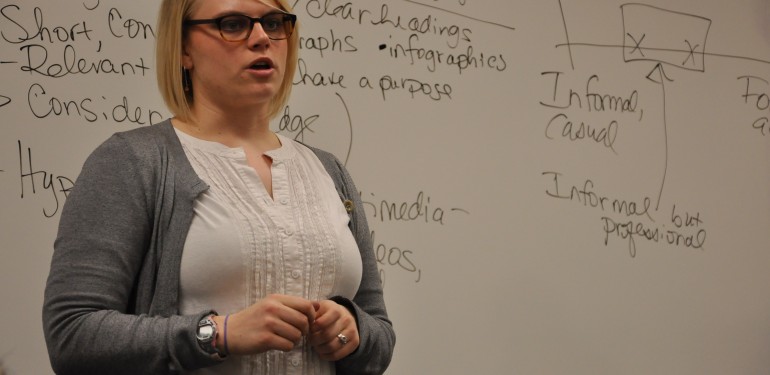This story was originally published in the March 23 print issue.
Mason English professor Danielle Harms was recently profiled in the New York Times’ blog The Learning Network, for a new method of teaching English Composition to Mason students.
The Learning Network is a website that offers “rich and imaginative materials for teaching and learning using New York Times content,” according to their website. Some of the content they post includes lesson plans, student opinion pieces, news quizzes and ideas from readers.
Last semester, Harms sent in her own idea.
“Months ago, kind of on a whim, I impulsively submitted that idea. I thought ‘it draws heavily on the New York Times, I really like this project and I’ve worked hard on it, so maybe I’ll try and share it,’ and then I heard nothing, and I forgot about it for months. And it was just in February or late January when an editor contacted me and said they wanted to run with it,” Harms said.
Harms has been developing this method for about three years. It begins with Harms assigning her students the following project: “The New York Times editors are proud of the writing they publish in the Room for Debate series, but they have noticed a problem: The responses are brief, and often interested readers are left wanting more. That’s where you come in. The editors have decided to expand the Room for Debate series by publishing a few thorough and in-depth essays responding to the debate questions.” She then asks her students to write an essay answering one of the previous debate questions featured on the Room for Debate series.
The first step for students is completing an in-class writing assignment that Harms says is her favorite step in the process. Students decide what question from the Room for Debate series they are interested in, and then they read that article and research it.
The next step is slightly different from normal composition projects – students pretend to have lunch with the New York Times editors to discuss their idea.
“Once that’s done, I tell students …to imagine that the New York Times editors know that they are writing an essay in response to one of their “Room for Debate” questions, and that to help them understand the many sides of the debate, they thought it would be helpful for the student to go to lunch with some of the experts who weighed in on their “Room for Debate” question,” Harms said.
The students then write down the “conversation” they have with these experts. Harms described it as a great learning experience.
“I really like it because it’s playful and imaginative,” Harms said. She continued, saying “students come up with great stuff, and I get a kick from seeing how people portray the lunchtime conversation.”
“For some reason there’s always more than one person who includes the characters in the dialogue ordering drinks, and they always ask for Perrier,” Harms said. “I get a kick out of that too.”
The process finishes with peer review, a final draft and a “lessons learned” paper.
“We spend about seven weeks working on this project, and for many students it’s the longest they’ve ever spent on the writing process for one paper,” Harms said.
Harms said that her enthusiasm for teaching isn’t a rare occurrence.
“While I was thrilled to have my teaching resources featured in the New York Times, I also think the way I teach the research project is pretty reflective of an approach shared by many others in the Composition Department,” Harms said. She described other educators in the department as “professors working to engage students in creative and innovative ways.”
Eric Eisner, associate professor of English, agreed with Harms’ statement.
“I think in our composition program generally, instructors put a good deal of time and energy into coming up with assignments that help students think of their essays as a chance to do genuine writing,” Eisner said.
When Harms began thinking about this method of teaching, she said that she looks for ways to teach that will be “intellectually challenging” to students at any level, while teaching them skills they can apply to their professional, academic and social lives and allows them to write about something they are interested in, or that is in their academic field.
“I also look for something where students are working on an extensive writing process, where they’re kind of experimenting with ways of writing or steps in the drafting process that they can apply in other writing tasks,” Harms said.
As far as Harms’ students, she says that many of her students are surprised at how much they like being in a composition class, and at how much they learn.
Harms said that recently “a student admitted that she’s been pleasantly surprised by how helpful and applicable the class has been so far. I understand that reaction. It’s a required class and I always try to acknowledge to students on the first day that while I love teaching this class, I’m aware that when they look at their schedules a composition class may not be the shining star they’ve been looking forward to for months.”
Eisner said that the assignment “strikes me as the kind of assignment likely to produce much stronger, much more engaged and engaging essays than would a more traditional prompt along the lines of ‘just research something that interests you’ or ‘choose sides on some controversial topic.’” He also added that this assignment showed students that issues have “multiple viewpoints and areas of agreement and disagreement that cut across positions,” instead of the common essay that requires students to argue for or against a topic.
Harms sees this class as a way for students to develop skills they can use at Mason and in their professional lives.
“It’s a chance to exercise critical thinking skills and to investigate interesting questions that students are genuinely curious about. No matter what students do in their professional, social or civic lives they are sure to communicate, and the ability to do it well is invaluable.”
Photo Credit: Johannah Tubalado




